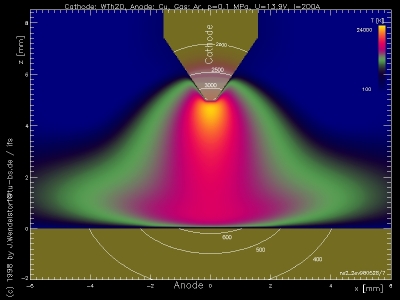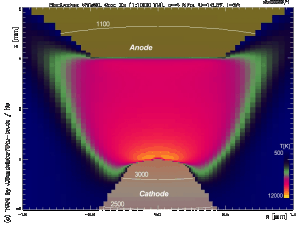Jens Wendelstorf:
 Modelling applications
Modelling applications
1. Application focused modelling of gas discharges
The results of this work can be be found in a consistent and
scientifically elaborated form in my
dissertation.
The following introduction is short, but somewhat outdated.
Modern numerical techniques allow for the computation of important
discharge parameters without any fitting procedures. Nevertheless,
the sophisticated calculation programs have to be validated for
their applicability.
Before trying to develop new products and
processes utilizing our software, well-known arc discharge
configurations were initially modelled.
Contrary to other approaches,
calculations are proven to be free of adjustments
to existing experimental data. Comparing the computation results
with measurement data enabeled us to proof the a priori
characteristic such a model should have:
- Discharge models with sufficient extrapolation capability may
not contain any input variables depending on the individual discharge
configuration (e.g. current, geometry...) - no fitting!
Furthermore, the comparison between model and experiment can
lead to a validation of the overall software package itself.
However this validation is limited by the lack or accuracy
of experimental data available or the differences between
several independent working groups, e.g.:
- 10% deviation in plasma temperature (the usual maesurement error),
correspond to doubling the total discharge current. I.e.
gas discharges are extreme nonlinear systems.
Independently of what is preferred by industrial users, a critical
examination of the literature for the case of
high intensity gas discharges (HID), resulted in essentially two
white mice, which are to be computed for model validation:
- The freely burning argon arc in LTE (0.1 MPa, approx. 100
- 300A) can be examined very economically and serves as a test case for
serveral phenomena of practical relevance:
- Hot spot formation at the electrodes.
- Convection dominated cathode jet.
- Important contribution of radiation losses.
- Stationary discharge in LTE at radial symmetry.
- The Xenon short arc lamp (4 MPa, approx. 6-12A) was
investigated accurately by Hoppstock (Karlsruhe ' 87) and is a good test
candidate for the case of high discharge pressures. An additional
phenomenon, which was examined by Hoppstock, is
- the mode transition of the cathode hot spot in LTE.
The next step is to make predictions for an unknown discharge
configuration and to calculate arc lamps of stronger commercial relevance:
- Xenon model lamp (1.0 MPa), which will be examined experimentally in Bochum.
- Xenon/mercury discharge at very high pressure (D1/D2
car lamp), selected due to their current industrial impact.
Low pressure gas discharges are actually not an objective, we limit
ourselves to so called thermal plasmas,
i.e. high pressure discharges (HID) in local thermodynamic equilibrium (LTE).
In the near future, we will be able to allow for deviations from LTE
(pLTE), increasing the application relevance. With rising computer performance and
growing experience in the control of these highly complex systems,
additional inclusion of kinetic effects will become possible,
as this is relevant to low pressure discharges.
A further important objective under investigation is the integration of
radiation transport. Spectral models will allow to predict
the wavelength distribution of the emitted radiation.
For introduction into the subject, refer to the
literature. In the following sections, current results are
presented only briefly. Work is focused on self-consistent prediction of
the overal discharge including the electrodes.
1.1 The atmospheric argon arc in LTE (0.1 MPa, DCEN, at least 50 A)
The computed discharge parameters coincide within measurement error (~5%)
with all experimental data available
(but due to Snyder, this arc may be also in pLTE, i.e. electron and heavy particle
temperature maps are significantly different - pLTE modelling results are underway).

Calculation of the (self induced) flow field in the argon arc plasma:
[MPEG-1 Video 640x480, 2.8 MB]
[AVI Video 640x480, 2.9 MB]
[AVI Video 800x600, 4.6MB]
Parameter study: Variation of total arc current:
Overview [AVI Video 800x600, 5.7 MB]
Cathode spot [AVI Video 800x600, 4.7 MB]
1.2 The (doped) xenon short arc lamp (4.0 MPa, DC, 8A)

The self generated flow in an arc lamp:
Flow field
[AVI Video 640x480, 50.3 MB]
Current variation (6 to 14A) [AVI Video 640x480, 2.46 MB]

Last modified: 9.10.1998
URL: http://www.wendelstorf.de/jens/e/work/applications.html
Contact: webmaster@wendelstorf.de

